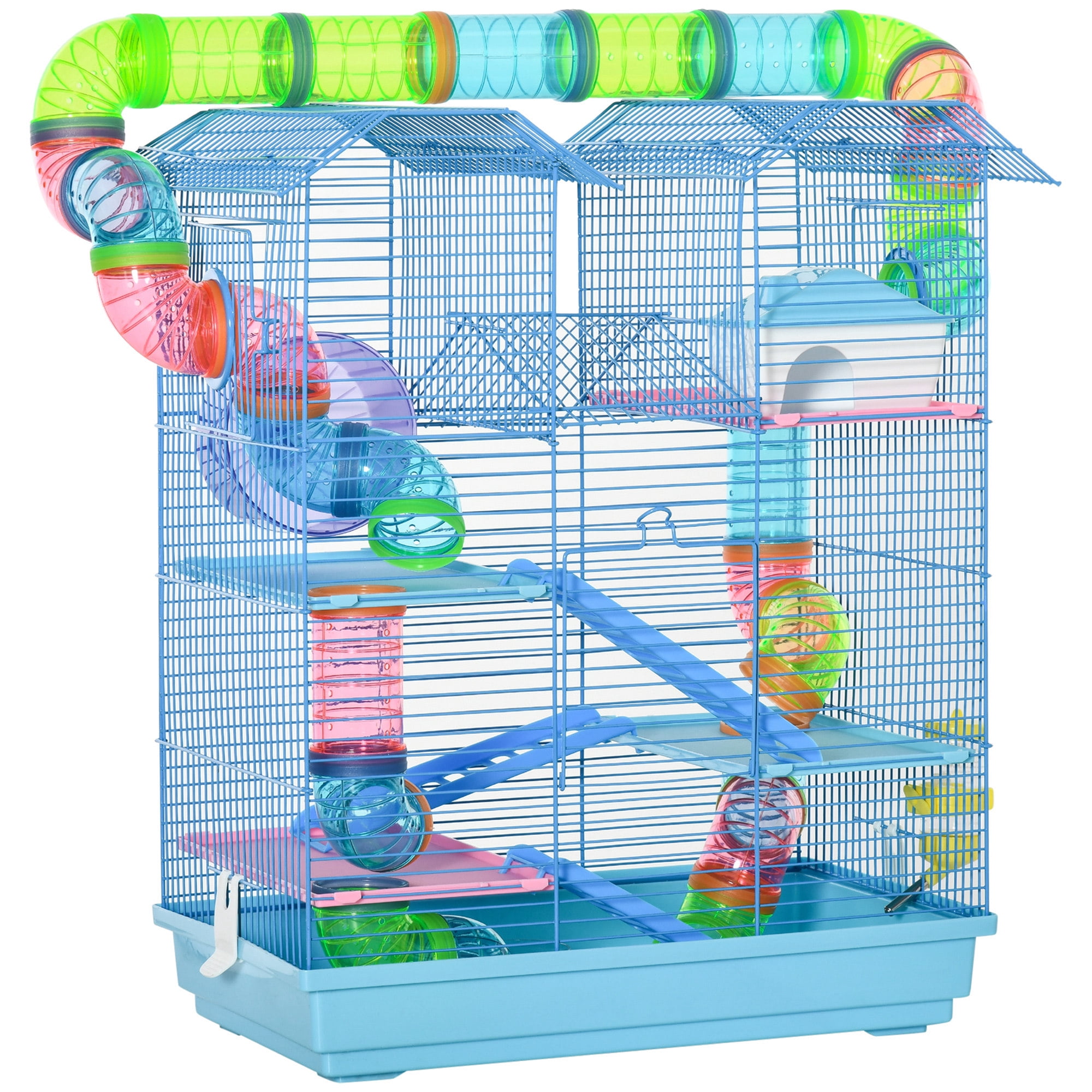Do you have a furry little friend that loves to run on their wheel all day? What plan have you set up for hamster exercise and movement activity? As it turns out, hamsters need more than just a wheel to stay happy and healthy. In this blog post, we’ll explore different exercise and movement activities to keep your hamster active and engaged. From obstacle courses to playtime outside the cage, your hamster will thank you for the extra love and attention.
1. The importance of exercise and movement activity for your hamster’s health
Your little furry friend needs to get moving to maintain good health. Exercise is crucial for hamsters as it promotes physical activity and curiosity, and without it, they can feel dull and stressed out. Providing opportunities for adequate exercise should be a priority for every hamster owner. To create an exercise-friendly environment, you can offer various exercise equipment, such as a hamster wheel or tube system.
As your hamster ages, understanding its exercise needs can help you adjust its routine accordingly. Exercise balls can be a great tool for hamsters, but it’s important to use them safely. Engaging your hamster in games and agility training can also offer an exciting way to get them moving. By avoiding common mistakes, using exercise to minimize stress and anxiety, and providing enough physical activity, your hamster can enjoy a long and healthy life.

2. Tips for creating an exercise-friendly environment for your hamster
It’s essential to create an exercise-friendly environment for your hamster to ensure they are healthy and happy. Providing a larger cage with plenty of space to run around, ramps, and tunnels will encourage your hamster to explore and exercise. Adding a wheel to the cage is also crucial to ensure they get enough physical activity. It’s important to keep in mind that hamsters need mental enrichment as well, so consider adding toys and hiding places in their cage. Giving your hamster time to settle in before handling them and being gentle when playing with them will also help reduce stress and anxiety. Remember, a happy hamster is a healthy hamster.

3. Types of exercise equipment for hamsters
Hamsters are active animals that require plenty of exercises to stay healthy and happy. There are several types of exercise equipment available for hamsters, including running wheels, tunnels, and exercise balls. Running wheels are a popular choice and come in various sizes and designs to suit different types of hamsters.
Tunnels provide an excellent opportunity for physical and mental stimulation, encouraging your hamster to climb up and down and explore its environment. Exercise balls are another great option, allowing your hamster to explore outside its cage in a safe and controlled environment. By providing your hamster with a variety of exercise equipment, you can ensure that it receives the physical and mental stimulation it needs to thrive.

4. Understanding your hamster’s exercise needs as they age
As they age, hamsters’ exercise needs may change, and it’s important for their owners to understand and accommodate these changes. Younger hamsters, for example, may have more energy and require longer bouts of exercise, while older hamsters may tire more easily and prefer less intense workouts. Additionally, as hamsters age, they may be more susceptible to certain health issues, such as arthritis, which may affect their mobility and require modifications to their exercise routines.
In order to create an exercise-friendly environment for your hamster as they age, it’s important to observe their behavior and adjust their exercise routine accordingly. This may entail providing softer, more cushioned surfaces for them to run on, or opting for lower-impact exercise equipment such as a slower moving wheel or gentle exercise toys.
By keeping these considerations in mind and being attentive to your hamster’s changing exercise needs, you can help ensure that they continue to be happy, healthy, and active throughout their lifespan.

5. How to safely use a hamster exercise ball
Using a hamster ball can be a fun and safe way for your hamster to exercise and explore their surroundings. However, it’s important to understand how to use the ball safely to avoid any harm to your furry friend. Before placing your hamster in the ball, make sure they are comfortable with the ball itself by letting them sniff and inspect it. Once your hamster is comfortable, place them in the ball on a level surface for no longer than 20 minutes at a time.
It’s essential to supervise your hamster while they’re in the ball and never leave them unattended. Additionally, make sure the ball is made of safe, durable plastic material and that it is appropriately sized for your hamster’s breed. By following these safety guidelines, you can provide your hamster with a stimulating and safe exercise experience.

6. Creative ways to engage your hamster in physical activity
In addition to traditional exercise equipment like running wheels and hamster balls, there are plenty of creative ways to engage your hamster in physical activity. One idea is to create an obstacle course using cardboard boxes and tubes, encouraging your hamster to climb and explore. Another option is to hide treats or small toys around their cage, encouraging them to forage and play. You can even try playing hide-and-seek with your hamster, placing them in a safe location and then encouraging them to search for you. Engaging your hamster in physical activity not only promotes their health, but also adds variety and stimulation to their daily routine.

7. The benefits of playing games with your hamster
Playing games with your hamster is not only fun but also very beneficial for their health and well-being. In addition to providing exercise, playing games can help to prevent boredom and stimulate your hamster’s natural curiosity. Some great games to try include hiding treats for your hamster to find, setting up obstacle courses, and playing with toys like tunnels and balls. It’s important to remember not to overwhelm your hamster with too much stimulation, as this can lead to stress and anxiety. By incorporating games into your hamster’s exercise routine, you can provide a fun and engaging way for them to stay active and happy.

8. Common mistakes to avoid when exercising your hamster
When it comes to exercising your hamster, there are a few common mistakes to avoid. First and foremost, never jerk or pull heavily on the leash when taking your hamster for a walk. Additionally, if your hamster doesn’t want to move, don’t attempt to drag them along. It’s important to provide your hamster with proper exercise equipment, like an exercise wheel, but make sure it’s the right size for your hamster to prevent spine issues.
It’s also crucial to keep males and females separate when exercising as they may fight. Finally, remember that hamsters are naturally active animals, so it’s important to engage them in physical activities, but do so safely and without overwhelming them. By avoiding these common mistakes, you can keep your hamster healthy and happy.

9. Using exercise as a tool for minimizing hamster stress and anxiety
Hamsters, like any other living creature, can experience stress and anxiety. Fortunately, exercise can help minimize these negative feelings. Regular exercise is essential for a hamster’s physical and psychological well-being, and it’s a great way to reduce stress and anxiety. By providing your furry friend with plenty of opportunities to move and play, you’ll help them stay active and engaged, reduce boredom, and promote overall good health.
Activities like playing with toys, running on a wheel or using an exercise ball can help hamsters release energy and burn-off stress during their active hours. It’s also essential to create a stress-free environment with plenty of hiding places and toys to help them feel secure. By understanding your hamster’s individual needs and implementing safe exercise techniques, you’ll be able to provide them with a healthy and happy life.

10. Adventures in hamster agility training
Adventures in hamster agility training can be a fun and engaging way to keep your furry friend physically and mentally active. This section builds upon the previous sections outlining the importance of exercise and ways to create an exercise-friendly environment for your hamster. Agility training involves setting up obstacle courses and challenges for your hamster to complete, such as tunnels, jumps, and balance beams. Not only does this provide exercise, but it also stimulates your hamster’s mind and natural instincts.
Training should be done gradually, with patience and positive reinforcement. It’s important to avoid pushing or stressing your hamster and always provide a comfortable and safe training space. With some creativity and patience, agility training can be a rewarding experience for both you and your hamster.
- From Babies To Adults: Navigating Hamster Development Milestones - April 14, 2024
- From Seeds To Treats: Unveiling The Secrets Of Hamster Diet And Behavior - April 14, 2024
- A Culinary Adventure: Discovering The Delightful Hamster Diet Variety - April 14, 2024


